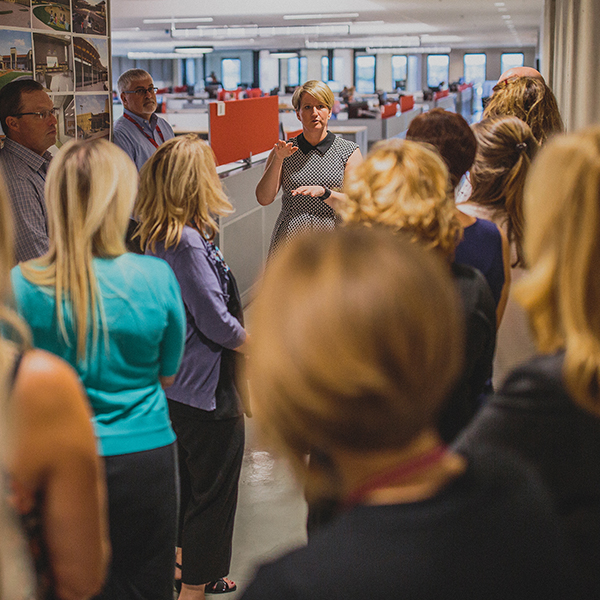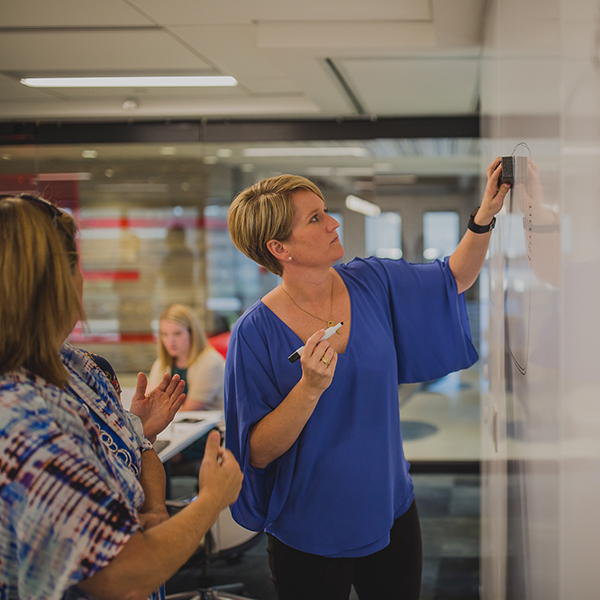
Huckabee’s MORE Momentum series highlights how our educational partners are investing their time, energy and focus to keep the momentum going during this unprecedented “pause.” We will explore themes related to bonds, planning, design and safety and security, among other topics that impact Texas public education. Follow us @HuckabeeInc on Facebook, Twitter, Instagram and Linked In, or complete the form below to get a first look as new content is released.
We’ve broken out each question for MORE Momentum #2: Planning below. You can be view the webinar in its entirety by clicking here.
As we find a sense of normalcy, many unknowns remain, especially for Texas schools. Despite the challenges, school districts can use this time to their advantage. Suzanne Marchman, a Director of Client Communications at Huckabee, visits with Dr. Bill Chapman, Superintendent of Jarrell ISD, and Mike Vermeeren, Director of Planning at Huckabee, to discuss how to gain insight and value into your short and long-term needs. This on-demand webinar focuses on ways Jarrell ISD is being intentional with their construction, operations and planning efforts, as well as ways in which school districts can engage in long-range planning (and its benefits) within a virtual work environment.
Q1: Tell us about Jarrell ISD and your needs going into 2020.
Jarrell ISD, located north of Austin, is growing at a quick pace with double digit increases in enrollment each year. Until 2007, it had a single K-12 school. Today, it has two elementary schools, a middle school and a high school.
The 2019-2020 school year focused on the opening of Igo Elementary School, construction to Jarrell High School and master planning at multiple campuses to address long-term capacity and evolving needs. Projections prior to COVID-19 placed Jarrell at capacity at the elementary level in 2.5 years and at the middle and high school levels in four. A strategic planning process was set to begin after Spring Break to address future bonds, but it was pushed back to summer following the shut-down of schools.
“We were beginning to look at those long-term growth needs and undergoing a master planning piece at the middle and high school campuses. We wanted to see just what were the capacities of those buildings, what could we do to those buildings to maximize our space. We are blessed with 120 acres at the high school site; how big could I build that structure to meet the needs of Jarrell High School as we grow? Then we can say, here’s what it can be, and what do we want it to be. Same with the middle school.” – Dr. Bill Chapman, Jarrell ISD
Q2: What has changed for Jarrell ISD since COVID-19?
Despite uncertainty, Jarrell ISD has continued to experience an increase in enrollment. They anticipate growth to continue and are working with demographers and developers to examine the pace and how it will impact their bond cycle in the coming year. While construction won’t stop, a slow-down may afford the district time to back off their building spree, push a bond out further and dive deeper into their needs.
“How do you plan for the future when the kids are here, but they’re not here. In Jarrell ISD, we are still seeing growth; our enrollment has increased during COVID-19. We were speeding along I-35 with our cruise control at 70 miles per hour, but now we’ve backed down to 30. It’s allowed us to back off and really see what our needs are going to be, what does it look like in November, do I have to have a November bond.” – Dr. Bill Chapman, Jarrell ISD
Q3: What are ways school districts can take advantage of this “pause” to be intentional?
Mike Vermeeren suggests that this “pause” can be viewed as a grace period, a time to reflect and plan. Visioning, master planning and long-range planning can all occur during this time, potentially with greater engagement and participation.
(1) Long-Range Planning—The foundational elements of long-range planning (facility assessments, educational standards and capacity / utilization) can be addressed even within our current situation. Empty buildings are ideal for facility assessments, and Huckabee has a method to conduct these that requires minimal personnel. To take it further, existing floorpans can be used as a base for utilization analysis; compared against TEA standards and your educational delivery methods, we can develop an educational adequacy report and capacity analysis that complements data gathering efforts.
“In terms of looking at growth needs, aging needs and evolving needs of education, we can do all of that right now. In terms of looking at the future, we are successfully conducting visioning meetings virtually with groups of 5-20. We can do that right now using fun and engaging methods.” – Mike Vermeeren, Huckabee
(2) Engagement—Virtual settings create more opportunity to connect with your internal stakeholders and/or community. Planning is often rushed; we see school districts spend a great deal of time collecting the goods related to educational and facility planning but then rushing through the buy in. If you’ve recently gone through a planning process, or are interested in starting, this is a good time to roll out your plan to your stakeholders and help them understand the need by finding ways to reach them where they are most comfortable.
TIP: Planning doesn’t have to be complicated. Now is a great time to collect data and start building your case for aging conditions, growth and evolving needs. And, there are many ways (and benefits) to engage your community and stakeholders virtually.
Q4: What are the benefits of long-range planning?
Long-range planning provides school districts with a clear understanding of needs, which helps them move forward strategically. The process creates a roadmap for future success—5, 10 or 20 years into the future. It also creates milestones that “trigger” the next step in the process, ensuring your plan isn’t derailed. Trigger points can be tied to a number of factors, but commonly relate to growth rate and capacity; they are a mechanism that is used to indicate when planning for the next building project should begin.
TIP: Work with your planning committee to develop “trigger points” to keep you on track when implementing a long-range plan. Trigger points indicate a milestone, typically related to growth and capacity, that prompt you to begin the next step in your process.
Q5: What opportunities have emerged for Jarrell ISD?
Time is the greatest opportunity for Jarrell ISD. They have been able to slow down (or speed up in one aspect) to capitalize on opportunity in several aspects of their operations, including:
(1) Construction—Jarrell ISD had a chance to accelerate phases in their high school construction project. Without students in the space, the contractor was able to access the library and cafeteria earlier than expected. Jarrell and the contractor capitalized on this opportunity; this shift has the potential to offset a busy construction period during August, when contractors are wrapping up projects as students return.
(2) Energy Savings—With schools closed, Jarrell utilized this time to analyze energy costs across all buildings. They realized savings potential in their administration building—an older, and smaller, space with energy cost above a new elementary school. As a result, they are making changes that will result in long-term savings. It’s an area that may have been overlooked had the district not had this opportunity to examine existing processes.
TIP: Explore opportunities with current and potential construction projects to take advantage of the current climate. Can you accelerate your timeline by giving contractors access to empty spaces? Or, can you push a project to bid in today’s favorable market?
TIP: Look for value. Be open to examination of process and operations. Don’t be afraid of change.
Q6: How has Jarrell ISD addressed planning needs during this pause? What are your successes?
In Jarrell, like many other school districts, they are constantly working toward the next goal at breakneck speed. This pause gave them time to dig into their goals, analyze their successes and examine what the future may hold (and how they should react). Prior planning efforts and the opportunity to build on those successes will allow Jarrell to best serve their community in this changing environment.
(1) Technology—A big focus for Jarrell is technology. The planning they’d done before COVID-19 set them up for success when learning went virtual. They were able to react quickly to support their 1:1 culture, expand WiFi at community schools and provide hotspots to families. The district plans to continue their efforts around technology planning and will start targeting teacher and staff development in their next phase.
(2) Community Engagement—An unexpected boon that may elevate the district’s future approach to community engagement, is the success they found in virtual meetings. “One of the benefits of this is that we had the best attendance to a district improvement plan we’ve ever had because no one had to come to the building. We had a virtual meeting. We had more parent participation, and so maybe we keep looking at this. There is no reason why we can’t use Zoom or Google Hangouts, things that our teachers are using. It’s an unintended consequence in a good way.” – Dr. Chapman
(3) Educational Delivery—Finally, the pause gave Jarrell the opportunity to examine educational delivery and ask, “Why is it this way, does it need to be this way, what is something else we can do?” Dr. Chapman has encouraged a mindset that has allowed for growth without fear of failure—a way of thinking that allows for greater innovation, especially during a crisis. “We have to have that focus on everything we do, and not just this one time transition. I think this will give us a better mindset as we move forward as a district, as a leadership team and as a teaching staff.” – Dr. Chapman
TIP: Virtual meetings have the potential to create broader engagement with your stakeholders and community. Consider how these can be used to generate feedback, buy-in and collaboration.
Final Thoughts
Despite the unknowns, there is a great deal of opportunity during this time to reflect, assess and plan for the future. In closing, here are a few considerations that have led to success for Jarrell ISD:










